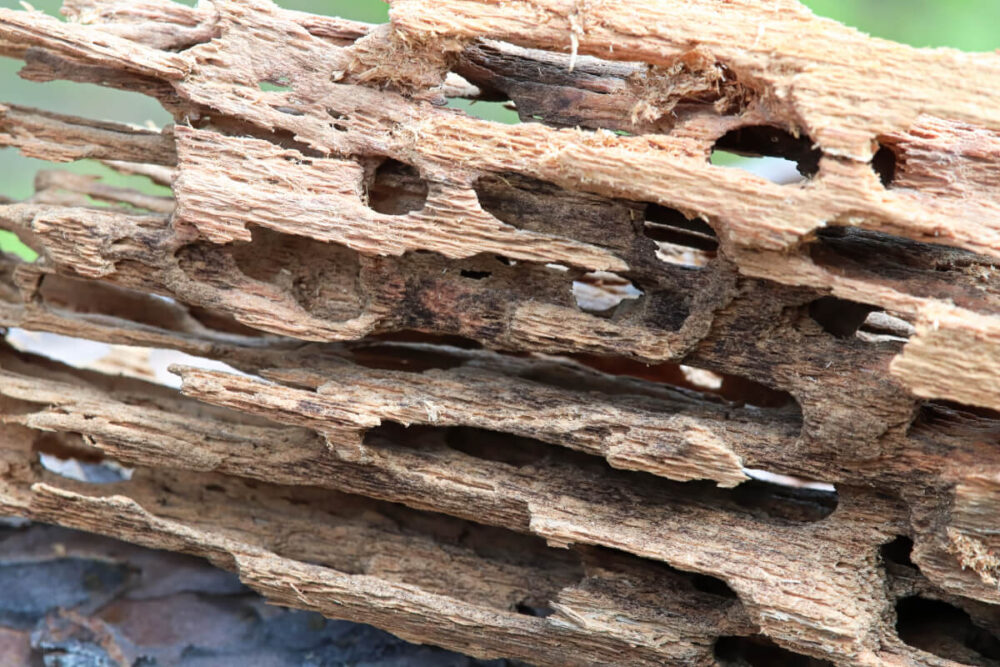
Termites and carpenter ants are two of the most destructive pests that can be found within a property. Although they can be easily mistaken for one another due to their close similarities in behavior, there are several key differences between carpenter ants and termites. One of the ways to know which type of pest you have is to assess their wood damage.
So what exactly is the difference between carpenter ant damage and termite damage? If you tap on a wood surface and hear a hollow sound, it’s more likely that you have a termite infestation. They can leave mud tubes and can cause paint to bubble on wall surfaces. On the other hand, carpenter ants like to create smooth galleries or tunnels inside moist or damaged wood. They can also construct kick-out holes where they leave piles of wood shavings.
Both termites and carpenter ants are notorious for being wood-destroying insects. One of the most frustrating aspects of these pests is that they are so tiny that they can go undetected for a long time and you wouldn’t notice their infestation until you’ve seen visible property damage.
Most of the time, termite damage and carpenter ant damage can be found on the surfaces and inside the wooden structures that they’ve infested. Both pests typically prefer wood that has water damage but there are also specific termites that like dry and sound wood such as drywood termites.
To confirm whether the damage was caused by termites or carpenter ants, you’d need to closely examine the exterior and interior of the wood material. Here’s how you can tell apart termite damage from carpenter ant damage:
Termites and carpenter ants have a habit of creating tunnels or galleries inside wood. These structures usually serve as a pathway as they look for food sources. Termite galleries are messy and have an uneven surface since they aggressively chew through wood. They can also leave behind a trail of mud within their galleries.
Meanwhile, carpenter ants don’t necessarily eat wood but they simply create chambers where they can build their nests. They’re also more organized and cleaner than termites and their galleries have a smooth and finished appearance.
Another convincing sign of termite damage is when you see mud tubes. The construction of shelter tubes is essential for protecting the termite colony and it serves as their tunnel to forage for food.
For subterranean termite species, they can build their mud tubes from the ground up to the surfaces of outer walls. Some of the common areas where you can find them are around window frames, baseboards, crawl spaces, and structural beams.
The worker ants don’t create mud tubes like termites do but they can leave small holes on the exterior of the wood. Outside of these holes, you’ll see piles of carpenter ant sawdust or frass which consists of chewed-up wood materials that they’ve pushed out from their nests.
The wood that termites have destroyed will likely make a hollow sound when tapped. This happens because termites can completely consume the interior of the wood which weakens the structure and leaves only the outer shell of the wood. It’s also likely that a termite-damaged wood will crumble or crack when it’s touched.
You may also hear a noise within your walls or wooden structures which is a sign of carpenter ant activity. Since carpenter ants are nocturnal, they often make rustling sounds as they move within the wood during nighttime. If you hear a strange sound inside your walls at night, it’s likely you have a carpenter ant infestation.
It’s hard to confirm a carpenter ant damage unless you open a section of a wood to inspect for the presence of their tunnels or visibly see a trail of worker ants on the wood surface. On the other hand, it’s easier to detect termite damage since they leave visible pieces of evidence.
Termites can cause peeling of paint on walls, the appearance of unusual patterns on drywall, and buckling wood that looks like water damage. They can also damage laminate floorboards and change the structure of wooden doors and window frames which makes them harder to open and close.
Aside from comparing the extent of their damage, termites and carpenter ants can also be distinguished from each other with their distinct appearances, nesting behaviors, diet, and swarming activity.
| Termites | Carpenter ants | |
| Appearance | Termites have a rectangular body shape with a broad waist. They have a set of straight antennae on the top of their heads. Their color can vary depending on their caste. Worker termites can have light or creamy white bodies and termite swarmers can appear black or dark brown. Their swarmers also have sets of wings that are of equal size and appear longer than their body. | Carpenter ants generally look like big black ants and they have a well-defined and distinct waist. Their antennae commonly appear bent on their head. Their swarmers also have a set of ant wings that differ in length, with the hind wings shorter than the ones in front. |
| Nesting behavior | Each type of termite has unique nesting characteristics. Subterranean termites prefer to nest underground. Dampwood termites have high moisture requirements and typically live inside tree stumps, logs, and fence posts. Drywood termites can build their colony structures inside sound wood such as in structural timbers, wood framings, and furniture. Carpenter ants prefer to establish their nests inside decaying or moist wood. Diet Termites will eat anything that has cellulose and that includes paper, wood, cardboard, plants, and insulation. | Carpenter ants can feed on food with protein and sugar. They’re mostly drawn to pet food, meats, honey, jelly, and other sweet snacks. However, they can’t directly consume solid food so they need water to make edible bits of food. |
| Swarming activity | The optimal time for subterranean termite swarmers is during the months of spring. Meanwhile, dampwood and drywood termites usually only come out in the summer months. | Carpenter ant swarmers come out in the spring months. |
To prevent costly repairs and structural damage, it’s important that you immediately call a pest control professional when you see the first signs of termites and carpenter ants at home. It’s crucial to locate the nesting site of a mature colony to effectively eliminate its entire population.
Setting up a bait tube or bait station can exterminate termite colonies and control ant activity. You can also clean surfaces or floors with essential oils to disrupt the ant trails and repel them for a period of time. You should also replace any damaged structural wood and remove old furniture which may attract more termites and carpenter ants.

You don’t have to deal with termites and carpenter ants infestation on your own. With the help of our expert team at Yale Pest Control, we can inspect your home and accurately pinpoint the source of your pest problem.
We offer quality pest control services including extermination, inspection, and preventative solutions to keep your property free from termites and carpenter ants. Contact us today to schedule a home visit and get a customized pest management program.